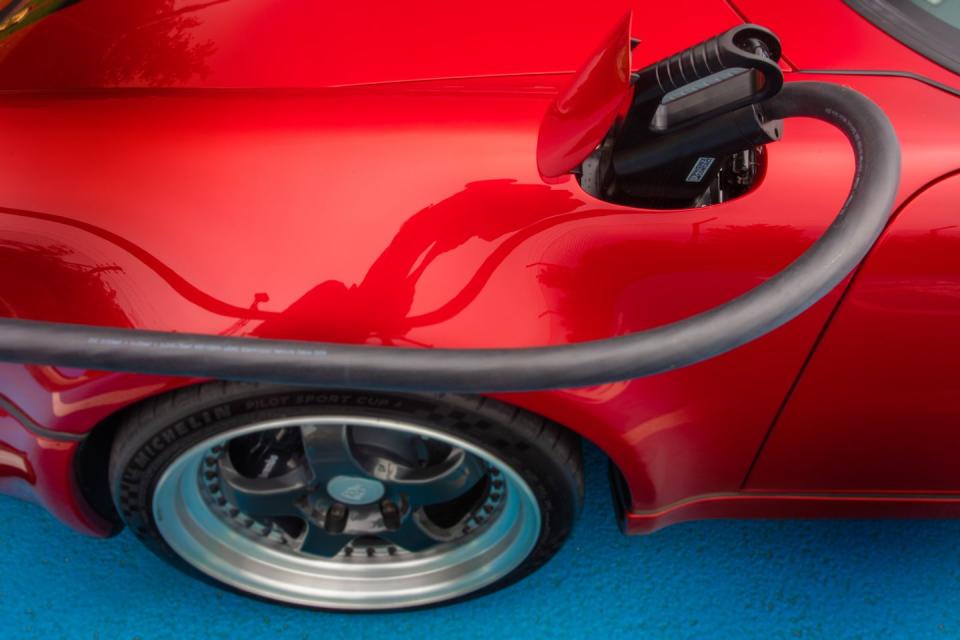The Everrati Signature Takes the Air-Cooled Porsche 911 Electric

Poll the owners of 964-generation Porsche 911s about how they would improve their cars and answers would likely include fewer oil leaks on their driveways and HVAC systems able to add actual heat or chill. We suspect very few would choose to rip out their car's air-cooled flat-six engine and replace it with a pair of electric motors.
But this is exactly what a new United Kingdom-based startup called Everrati is offering to do in return for the small matter of about $360,000 plus a donor 964 (1989 through 1993 911 models). The conversion is designed to be reversible, although it seems unlikely anyone spending so much money would ever do so. The upshot is a car that promises to be as quick as the mighty Turbo 3.6 was while weighing less than the contemporary Carrera 2. Everrati claims a weight of 3090 pounds.
Let's leave the contentious question of why until later because the what is certainly impressive. The Signature is considerably more than just a powerplant transplant; it's been rebuilt to a standard that doesn't feel far removed from one of Singer's pieces of rolling rear-engined art. Everrati's demonstrator uses a Turbo-style wide body, but it will also perform conversions on lesser 964s. There are some modern details but not too many—LED headlights being the most obvious. The paint finish is impressively crisp, and fat Michelin Pilot Sport Cup 2 tires sit on period-appropriate aluminum alloys. It even has exhaust tailpipes, but we'll get to those later.

While the 964's core structure hasn't suffered radical change, the demonstrator's doors, roof, hood, and duckbill spoiler are made of carbon fiber to help save weight. Fitting the electrical powertrain wasn't easy. Many (if not most) cars from the 1980s would be easier to convert, given the packaging constraints of the Porsche's tight-fitting engine.
In the demonstrator, two Tesla-sourced AC induction motors drive the rear axle, which is fitted with a limited-slip differential, through a common input shaft. (Everrati plans to switch customer cars to a pair of compact modular permanent-magnet synchronous motors from Integral Powertrain from the same family that will power the Lotus Evija.) The space remaining in the rear wasn't sufficient to accommodate an appropriately sized battery, so there are two packs—the larger one in the back with a smaller one in front of the passenger compartment. These run at 400 volts, have a usable capacity of 50.0 kWh, and are connected by a cable that passes through the former transmission tunnel. (There is still room up front for a small frunk.)

Unusually for an aftermarket EV conversion, the Signature supports fast charging through a port located under its vestigial fuel-filler cap. This can support DC fast charging up to 80 kW, allowing the battery to be taken from 20 percent to 80 percent in about 45 minutes. Everrati doesn't quote an official range yet, but it says the car has managed more than 150 miles between charges in real-world conditions.
The Signature's cabin has been retrimmed to a high standard that corresponds to its external finish and features Porsche's own touchscreen infotainment system for older cars. From the driver's seat, the obvious change is with the repurposed analog instruments, with the tachometer turned to a flow/charge meter and the supplemental dials now reporting on battery voltage and charge plus the temperatures of packs and motors.
Turning the key in an elderly Porsche and being rewarded by the sound of silence is far from an unusual experience, the difference with the Everrati being that it can still move away without the busy clatter of an air-cooled flat-six. The experience of a near-noiseless 964 is a deeply incongruous one, something that barely diminishes after an hour in the car. There are other small aural distractions: The 12-volt pumps for the hydraulic power steering and vacuum brake booster can be heard when the car is stationary, road and suspension noise are more obvious when moving, and the rear-mounted motors produce a distant accelerative hum under harder use. That's where the difference between this 964 and an original is clearest.

Even the sportiest sports cars suffer from relative performance deflation over the span of three decades—the basic Carrera of this generation made just 247 horsepower—but the Everrati feels impressively muscular by 2021 standards. The company claims it will be able to go from zero to 60 mph in less than four seconds, which is what we figured for the 964 Turbo in 1994, and performance would likely be similar until at least 100 mph. Beyond that, the Everrati's acceleration diminishes quickly. Top speed is governed to around 130 mph.

 Yahoo Autos
Yahoo Autos